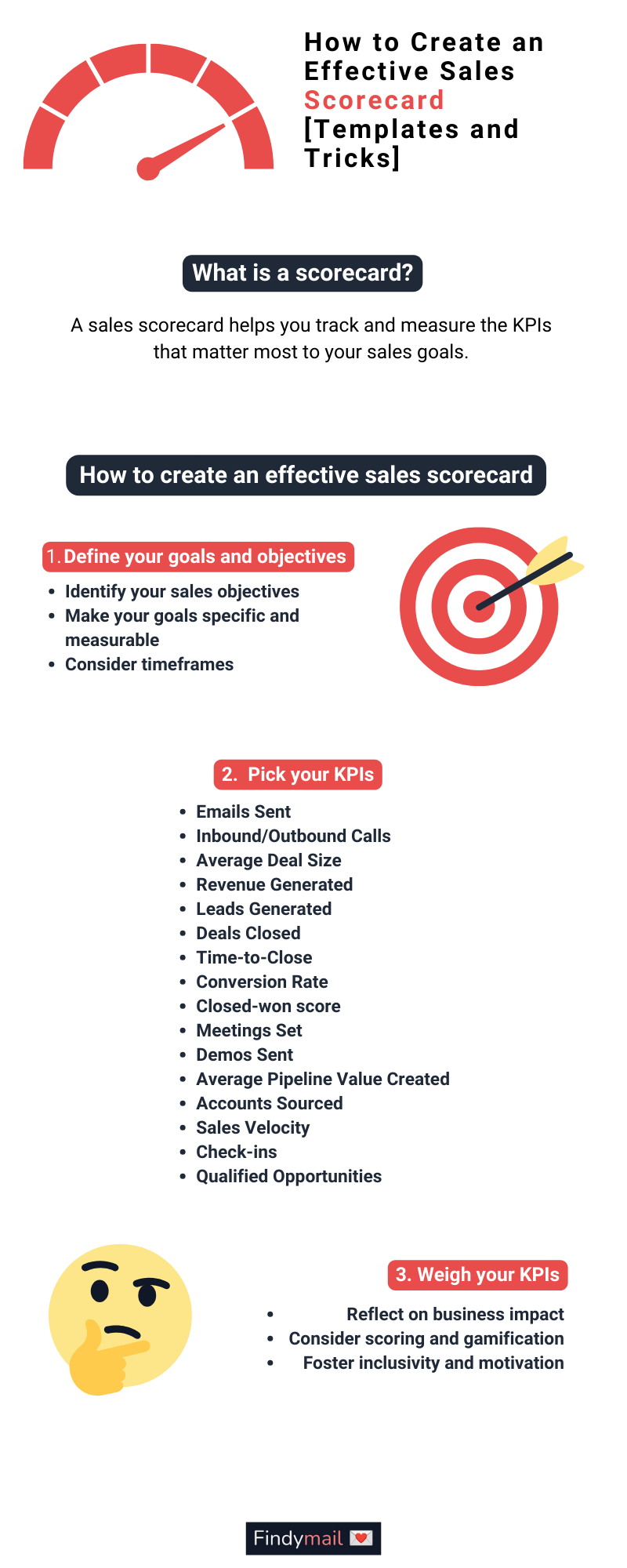We all know that sales reps are the lifeblood of most businesses. They're the ones that bring in the revenue and profit, driving the success of the company. But how do you measure the effectiveness of your sales team?
Answer: using a sales scorecard. Now, a sales scorecard is more than some numbers on a spreadsheet. It helps gauge your teams’ efforts, shows where they can improve, and holds them accountable.
Whether it’s cold calling, cold emails, or even going door-to-door, a sales scorecard can help make sure your team stays on track.
In this article, I'll go over what a sales scorecard is, why you need one, and how you go about creating one that actually gets you results.
Let’s dive in!
The Sales Scorecard Explained
So, what the heck is a sales scorecard?
Imagine it as your ultimate performance dashboard, giving you a snapshot of how your sales team is doing.
It’s a tool that helps you track and measure the KPIs that matter most to your sales goals. It's not just some fancy spreadsheet but a visual representation of your team's progress.
It's all about celebrating wins, identifying areas for improvement, and making data-driven decisions.
By using one, you can keep your finger on the pulse of your sales operation. It goes beyond just staring at revenue figures. It brings together a bunch of metrics that contribute to your sales success, so you can see the bigger picture.
With a sales scorecard, you can easily:
- Spot trends
- Recognize top performers
- Foster a bit of healthy competition
- Replicate successful strategies
Plus, it helps you figure out where your team might need a little extra support or training.
So, whether you're checking out individual achievements or looking at the collective effort of your sales team, a sales scorecard gives you a dynamic, centralized hub to monitor and evaluate what's working and what needs tweaking.
The Predictive Scorecard
Imagine having a crystal ball that reveals valuable insights into your sales team's potential performance. That's precisely what a predictive scorecard offers.
It lets you anticipate performance issues, identify individual strengths and weaknesses, and deliver personalized coaching.
A predictive scorecard goes beyond surface-level assessments, providing a comprehensive understanding of each sales rep, so you can anticipate potential hurdles and tailor your coaching strategies.
Use Cases for Sales Scorecards
Typically, you’ll use scorecards in three scenarios:
- Individual coaching
- Weekly team evaluations & meetings
- Regularly reviewing overall sales performance on a monthly or quarterly basis
The goals here are two-fold: keeping the team on track to reach the company goals and identifying weak links that are underperforming.
Let’s take a closer look at how scorecards make this happen:
1) Sales Scorecards for Individual Coaching
Picture this: you're sitting down with one of your sales reps, let's call him Mark, for a one-on-one mentoring session. With a sales scorecard in hand, you have a comprehensive snapshot of Mark's performance, allowing you to identify areas for growth and provide tailored guidance.
You can see his leading indicators, production metrics, and efficiency metrics – including things like the number of qualified leads, closed deals, and call-to-close ratio.
Armed with these metrics, you can have a data-driven conversation with Mark, focusing on specific areas for improvement, setting achievable goals, and providing targeted coaching so you can help Mark unleash his full potential.
For example, he may be generating many qualified leads, but his closed deals percentage may not be as high. With a sales scorecard showing you that, you can discuss new strategies he could try to increase his closed deals score.
2) Weekly Team Evaluations
Gather 'round the conference table – it's time for the weekly team meeting! Sales scorecards play a pivotal role in these sessions, promoting collaboration and holding the team accountable for their collective success (or misses).
During the meeting, the sales scorecard serves as a compass, guiding discussions and providing a holistic view of the team's performance.
You’re looking at customer satisfaction metrics, average deal size, and conversion rates.
With these in hand, it becomes a visual representation of the team's journey. You now see where you guys can work together to streamline processes and work collectively to tackle obstacles.
For example, you may see that you’re struggling with the average deal size. Once you’ve identified that as an improvement area, you and the team can jam on it and create strategies to keep you focused on resolution.
3) Regular Reviews
When it’s time for your monthly or quarterly review, the sales scorecard takes center stage as you evaluate progress, set strategic goals, and ensure your team continues to excel.
Looking at KPIs like pipeline value, revenue generated, and time-to-close, you can accurately assess the team’s performance and benchmark against targets to anticipate future success or any roadblocks coming your way.
How to Create an Effective Sales Scorecard
When it comes to crafting a sales scorecard that will get results, it requires careful consideration, thoughtful planning, and a pinch of creativity.
But I will walk through the process of what you need to do!
1) Define Your Goals & Objectives
The first and most crucial step is understanding what you want to achieve with your scorecard. If your goals aren’t clear, it’s like driving without the headlights on– no idea where you’re headed, and it might lead to you crashing.

Here’s what you need to do:
- Identify Your Sales Objectives: Take a moment to reflect on what you want to achieve with your sales team. Is it increasing revenue, expanding market share, improving customer satisfaction, or something else? Clearly define your objectives to provide a direction for your scorecard.
- Make Your Goals Specific and Measurable: Vague goals won't cut it. Ensure your objectives are specific and quantifiable. For example, instead of aiming for "increased revenue," set a target of "10% revenue growth in the next quarter." Specific and measurable goals enable you to track progress accurately.
- Consider Timeframes: Determine the timeframe for your goals. Are they short-term or long-term? Setting time frames helps create a sense of urgency and allows you to monitor performance within defined periods.
2) Pick Your KPIs
When it comes to building your sales scorecard, the KPI metrics you choose to track will depend on your goals and the specific roles within your sales team.
For example, the scorecard for a BDR will be different than an Account Executive's.
Here are some common KPIs that might show up on your sales scorecard:
- Emails Sent
- Inbound/Outbound Calls
- Average Deal Size
- Revenue Generated
- Leads Generated
- Deals Closed
- Time-to-Close
- Conversion Rate
- Closed-won score
- Meetings Set
- Demos Sent
- Average Pipeline Value Created
- Accounts Sourced
- Sales Velocity
- Check-ins
- Qualified Opportunities
My recommendation is to zero in on three to five of the most important metrics to you, your team, and your company targets.
If you need help figuring it out, use sales data from your CRM or sales intelligence platform.
3) Weigh Your KPIs
Finally, you need to weigh your metrics to determine which ones are more important than the others.
Not to say that some metrics are inherently better or worse, but you must consider how each metric reflects on your business and its specific goals.
- Reflect on Business Impact: Take a step back and evaluate the impact of each metric on your overall business objectives. Consider the direct influence a particular metric has on driving the desired outcomes.
- Consider Scoring System and Gamification: If you want to gamify your scorecard, attach scores or points to each metric – but make sure the score aligns with its weight.
- For instance, closing a deal could earn 10 points, while booking a demo may be worth 8 points. This approach promotes engagement, motivation, and healthy competition among your team members.
- Foster Inclusivity and Motivation: You want to create opportunities for everyone to contribute and feel motivated. It recognizes that different actions hold varying degrees of importance and encourages continuous improvement across the board.
Sales Scorecard Tools, Templates, and Examples
There are several ways you can go about making your sales scorecard.
For instance, you can simply fire up Excel or Google Sheets and use an ordinary spreadsheet. Here’s an example of what that could look like:
However, that’s a bit bland.
Luckily, there are tools that are not only prettier but give you visualizations so you can literally see your team’s performance over time. For example, there’s LevelEleven’s Performance Scorecard which gives you real-time assessments on an individual and team level.
There’s also Brainshark which integrates with CRMs like Salesforce and Hubspot if you’re already using them:
However, if you want to keep it simple, here are a few templates you can just download and start using now:
Get Ready to Score Big with Sales Scorecards!
In a nutshell, having a killer sales scorecard is a game-changer when it comes to boosting your sales team's performance. It's like having a secret weapon that helps you keep tabs on the numbers that matter, identify areas for improvement, and guide your reps to victory.
However, a strong sales strategy goes beyond just tracking metrics. It also relies on having accurate and reliable contact information for effective outreach. That's where Findymail can help.
With Findymail, you can equip your sales reps with real, verified email addresses, ensuring they reach the right prospects and maximize their chances of success.
Ready to empower your sales team with the right tools? Sign up now for Findymail and get 10 FREE valid email addresses.






